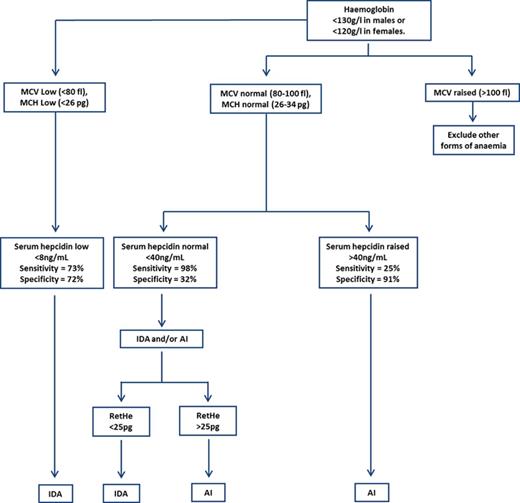Abstract

Introduction
Iron deficiency anaemia (IDA) and anaemia of chronic inflammation (AI) are the most prevalent causes of iron related anaemia in subjects with gastrointestinal disorders contributing significantly to morbidity and mortality. Diagnosis of IDA and AI is not always straight forward and currently a combination of several serum parameters (ferritin, transferrin, transferrin saturation, iron and C-reactive protein) is required. Subjects with a mixed aetiology can be difficult to interpret using traditional serum parameters, particularly in the presence of an inflammatory process. Hepcidin (a 25 amino-acid peptide hormone) in conjunction with reticulocyte haemoglobin equivalent (RetHe) has the potential to differentiate IDA from AI and in cases of mixed aetiology replacing the traditional laboratory parameters (serum iron, CRP, transferrin saturation and ferritin).
Aim
The aim of the study was to evaluate the performance of a commercially available ELISA assay and investigate whether hepcidin and RetHe can differentiate AI from mixed aetiology.
Method
The study investigated 77 patients with gastrointestinal disorders associated with anaemia in a secondary care setting using a traditional pathway of 6 tests (figure 1): Complete Blood Count (CBC), Reticulocytes, serum ferritin, CRP, transferrin, serum Iron. Hepcidin concentration was measured using a commercially available ELISA method (DRG Diagnostic GmbH, Marburg, Germany), CBC and RetHe using a Sysmex XE-2100 CBC analyser, iron parameters and CRP using Beckman Coulter platforms.
Results
Hepcidin correlated well with ferritin R2 = 0.79, p<0.0001. The results were compared to traditional parameters with Receiver Operator Curves (ROC) used to determine diagnostic cut off concentrations (table 1).
Sensitivity and specificity of serum ferritin and serum hepcidin used to determine diagnostic cut off values.
| Selected cut off values . | IDA . | AI . |
|---|---|---|
| Serum ferritin 30.0µg/L | Sensitivity 83% Specificity 64% | Sensitivity 55% Specificity 75% |
| Serum hepcidin 8ng/mL | Sensitivity 73% Specificity 72% | Sensitivity 70% Specificity 67% |
| Serum hepcidin 40ng/mL | Sensitivity 98% Specificity 32% | Sensitivity 25% Specificity 91% |
| Selected cut off values . | IDA . | AI . |
|---|---|---|
| Serum ferritin 30.0µg/L | Sensitivity 83% Specificity 64% | Sensitivity 55% Specificity 75% |
| Serum hepcidin 8ng/mL | Sensitivity 73% Specificity 72% | Sensitivity 70% Specificity 67% |
| Serum hepcidin 40ng/mL | Sensitivity 98% Specificity 32% | Sensitivity 25% Specificity 91% |
Ferritin was unable to distinguish IDA from AI in mixed aetiology situations. This gives rise to a new proposed 2 step pathway (figure 2) using 3 tests: CBC, RetHe and hepcidin differentiating IDA from AI in mixed aetiology cases indicating the cause of the anaemia. The RetHe value can then be used to predict the response to oral iron.
Conclusion
Serum hepcidin may not yet replace serum ferritin as the preferred iron status marker, but in conjunction with RetHe it may distinguish mixed aetiology subjects. This offers the potential development of a clearer clinical pathway for investigation of difficult subjects, including reduction in the number of tests required during anaemia investigations and shorter diagnosis times. The advantage of hepcidin together with RetHe over traditional iron parameters is both as a real time marker of iron status and an indication of likelihood of response to iron therapy. The patient would benefit from a shorter recovery time, unnecessary testing, reduction in ineffective treatment and overall reduction in costs.
Current diagnostic testing pathway using 6 independent tests with serum ferritin used as the primary indicator of iron stores.
Current diagnostic testing pathway using 6 independent tests with serum ferritin used as the primary indicator of iron stores.
Suggestion of a new 2 step diagnostic testing pathway with serum hepcidin as the primary indicator and reticulocyte haemoglobin equivalent as the predictor of iron deficiency and response to oral iron.
Suggestion of a new 2 step diagnostic testing pathway with serum hepcidin as the primary indicator and reticulocyte haemoglobin equivalent as the predictor of iron deficiency and response to oral iron.
Patmore:Janssen: Honoraria; Gilead: Honoraria.
Author notes
Asterisk with author names denotes non-ASH members.

This icon denotes a clinically relevant abstract



This feature is available to Subscribers Only
Sign In or Create an Account Close Modal